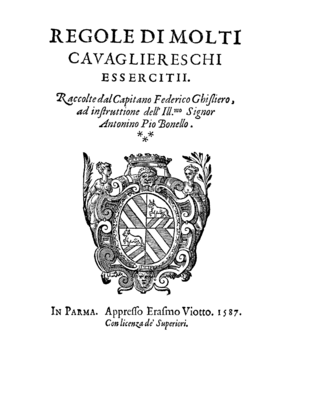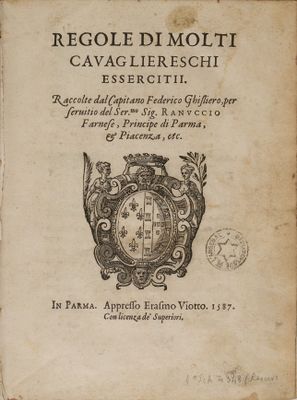|
|
You are not currently logged in. Are you accessing the unsecure (http) portal? Click here to switch to the secure portal. |
Difference between revisions of "Federico Ghisliero"
| Line 42: | Line 42: | ||
|- | |- | ||
| rowspan="2" | [[file:Regole di molti cavagliereschi essercitii Title (alt).png|400x400px|center]] | | rowspan="2" | [[file:Regole di molti cavagliereschi essercitii Title (alt).png|400x400px|center]] | ||
| − | | | + | | <p>'''Rules of many knightly<ref name="Cavagliereschi">''Cavagliereschi'' is Corsican for chivalrous. While the Italian is knightly.</ref> armies,'''</p> |
| + | |||
| + | <p>''Collected by Captain Frederico Ghisliero, in service to the Most Illustrious Lord Antonio Pio Bonello.''</p> | ||
| + | |||
| + | <p>'''In Parma.''' [published] by Erasmo Viotto. 1587.<br/>''Licensed by the Superiors.''</p> | ||
| {{paget|Page:Regole di molti cavagliereschi essercitii|Title (alt)|png|lbl=+ⅰ}} | | {{paget|Page:Regole di molti cavagliereschi essercitii|Title (alt)|png|lbl=+ⅰ}} | ||
|- | |- | ||
| − | | | + | | <p>'''To the Most Illustrious Lord Antonio Pio Bonello,''' son of the most excellent Lord Girolamo Bonello, Marquis of Cassano.<br/><br/></p> |
| + | |||
| + | <p>For two reasons, my Most Illustrious Sir, it has pleased me to direct to Your Most Illustriousness the present book of mine, which I have written here and now, and with good reason, on the use of arms. The first, so that with this new birth of mine I may wish you well, having intercepted with infinite pleasure the marriage which followed between you and the Most Illustrious Lady Octavia Bagliona: with which your Most Illustrious House may hope for a most happy succession:</p> | ||
| | | | ||
{{paget|Page:Regole di molti cavagliereschi essercitii|I (alt)|png|lbl=+ⅱ|p=1}} {{section|Page:Regole di molti cavagliereschi essercitii II (alt).png|1|lbl=+ⅱv.1|p=1}} | {{paget|Page:Regole di molti cavagliereschi essercitii|I (alt)|png|lbl=+ⅱ|p=1}} {{section|Page:Regole di molti cavagliereschi essercitii II (alt).png|1|lbl=+ⅱv.1|p=1}} | ||
| Line 71: | Line 77: | ||
|- | |- | ||
| rowspan="2" | [[file:Ghisliero_Title.jpg|400x400px|center]] | | rowspan="2" | [[file:Ghisliero_Title.jpg|400x400px|center]] | ||
| − | | | + | | <p>'''Rules of many knightly<ref name="Cavagliereschi"/> armies,'''</p> |
| + | |||
| + | <p>''Collected by Captain Frederico Ghisliero, in service to the Most Serene Lord Ranuccio Farnese, Prince of Parma, & Piacenza, etc.''</p> | ||
| + | |||
| + | <p>'''In Parma.''' [published] by Erasmo Viotto. 1587.<br/>''Licensed by the Superiors.''</p> | ||
| {{pagetb|Page:Regole di molti cavagliereschi essercitii (Federico Ghisliero) 1587.pdf|7|lbl=+ⅰ}} | | {{pagetb|Page:Regole di molti cavagliereschi essercitii (Federico Ghisliero) 1587.pdf|7|lbl=+ⅰ}} | ||
Revision as of 17:39, 19 March 2024
| Federico Ghisliero | |
|---|---|
| Died | 1619 Turin, Italy |
| Occupation |
|
| Nationality | Italian |
| Genres | Fencing manual |
| Language | Italian |
| Notable work(s) | Regole di molti cavagliereschi essercitii (1587) |
Federico Ghisliero was a Bolognese soldier and fencer. Little is know about his early life, but he studied fencing under the famous Silvio Piccolomini.
In 1587, he published a fencing treatise called Regole di molti cavagliereschi essercitii, dedicated to Ranuccio Farnese, who was 18 years old at the time of publication and would become Duke of Parma, Piacenza, and Castro. Ghisliero's manual is notable for his use of geometry in relation to fencing, and the incredibly detailed illustrations, using concentric circles centered on where the fencer has placed most of their weight (often, but not always, the back foot), and illustrating multiple versions of each figure in a plate, showing the progression of the movements he describes.
Contents
Treatise
Images |
Transcription | |
|---|---|---|
Rules of many knightly[1] armies, Collected by Captain Frederico Ghisliero, in service to the Most Illustrious Lord Antonio Pio Bonello. In Parma. [published] by Erasmo Viotto. 1587. |
[+ⅰ] REGOLE DI MOLTI CAVAGLIERESCHI ESSERCITII. Raccolte dal Capitano Federico Ghisliero, ad instruttione dell' Illustrissimo Signor Antonino Pio Bonello. In Parma. Appresso Erasmo Viotto. 1587. | |
To the Most Illustrious Lord Antonio Pio Bonello, son of the most excellent Lord Girolamo Bonello, Marquis of Cassano. For two reasons, my Most Illustrious Sir, it has pleased me to direct to Your Most Illustriousness the present book of mine, which I have written here and now, and with good reason, on the use of arms. The first, so that with this new birth of mine I may wish you well, having intercepted with infinite pleasure the marriage which followed between you and the Most Illustrious Lady Octavia Bagliona: with which your Most Illustrious House may hope for a most happy succession: |
[+ⅱ] ALL'ILLVSTRISSIMO SIGNOR ANTONINO PIO BONELLO, Figliuolo dell'Eccellentissimo Signor Girolamo Bonello, Marchese di Cassano. PEr due rispetti; Illustrissimo Signor mio; m'è piaciunto d'indrizzare à Vostra Signoria Illustrissima il presente mio libro, che quasi pur hora, et con buona occasione hò scritto sopra l'essercitio dell' armi. L'uno, accioche con questo mio nuouo parto io augurassi bene à lei, hauendo intesso con infinito mio piacere il martimonio seguito tra lei, & l'Illustrissima Signora Ottuioa Bagliona: col quale l'Illustrissima casa sua potrà sperar felicissima suc- [+ⅱv.1] cessione: si come desidero io, che'l medesimo mio parto sotto la protettione del nome suo viva lungamente sicuro. L'altro, accioche leggendo Vostra Signoria Illustrissima in questo libro quei precetti, che forse fin'hora le saranno venuti mostrati da buono Maestro nel maneggiar l'armi, possa riconoscere in essi la propria virtù, della quale con molte altre hà voluto in questa sua anchor tenerissima età essere ornata. Non sia dunque discara à lei questa mia fatica: che se bene potesse essere per se stessa debole, nondimeno col leggerla Vostra Signoria Illustrissima, ella prenderà senza dubbio tanto spirito, che sperarà du poter vivere assai più, che'l proprio vigore, & merito non le permetterebbono. Con che raccommandandomi in buona gratia di Vostra Signoria Illustrissima le bacio le mani. | |
[+ⅱv.2] Di Parma gli 22. d'Aprile. 1587. Di Vostra Signoria Illustrissima affettionatissimo Servitore Federico Ghisliero. |
Images |
Transcription | |
|---|---|---|
Rules of many knightly[1] armies, Collected by Captain Frederico Ghisliero, in service to the Most Serene Lord Ranuccio Farnese, Prince of Parma, & Piacenza, etc. In Parma. [published] by Erasmo Viotto. 1587. |
[+ⅰ] REGOLE DI MOLTI CAVAGLIERESCHI ESSERCITII. Raccolte dal Capitano Federico Ghisliero, per servitio del Sererenissimo Signore Ranuccio Farnese, Principe di Parma, & Piacenza, etc. In Parma. Appresso Erasmo Viotto. 1587. | |
|
[+ⅱ] AL SERENISSIMO SIGNORE RANUCCIO FARNESE PRINCIPE DI PARMA, ET PIACENZA. &c. LA gratia, Serenissimo Signoro; che Vostra Altezza s’e degnata a di farmi col servir si di me nell’occasione del giocar d’armi, m’ha ricordato, che ‘essermi adoperato solo con la persona nella medesima occasione sia stato poco; & che percio mio debito fosse di fare una raccolta, quasi in compendio, di tutto quello, cosi circa la Theorica, come circa la Prattica, ch’io col mostrare in parole, & con l‘operare con la persona, mi sono affaticato volontieri, per ubbidire a lei, d’esplicarle. Et questo ho fatto non per credermi o di saper perfettamente la professione [+ⅱv.1] dell’ adoperar l’armi (che la profession mia veramente non e questa; ma e quella di militia) o di poter con questo mezzo ricompensar la medesima gratia: perche nell’uno so certo di mancare in molte cose, se ben posso tenermi a molta ventura, & rallegrarmi meco stesso d’esser stato fattura dell'Illustrißimo Signore Silvio Piccolomini, alla cortesissima humanita del quale, in cio sempre mostrata verso me, ne rendo quelle maggiori gratie, che da me si debbono: nell’altro, come potrei io mai ricompensare a Vostra Altezza il ricevuto, s’a farlo non mi bastrebbono mille fatiche, ch’io ne spendessi di piu? | ||
[+ⅱv.2] Ma questo hò voluto fare, accioch'ella habbia segno da me della mia affettuosissima inclinatione, ch'io ho di continuamente servirla, & d'adoperarmi per lei con l'opera, come sempre farei con la vita. | ||
|
[+ⅱv.3] Aggiungo a questo un'ardentissimo desiderio, ch'anch'io ho insieme con gli altri suoi fidelissimo servitori. Il qual'è in questo primo fiore dell'et à sua di volerla aiutare in quello, che parimente da me si puo, per sumministrarle, ancho con questa via da me mostrata, occasione, ond'ella possa assuefarsi all'essercitio della persona: il quale quanto pro- [+ⅲ.1] fitto faccia in universale alla piu sicura conservation della vita, lo mostrano coloro, che particolarmente hanno trattato di questo. | ||
[+ⅲ.2] Lo mostrano tanti Gimnasii, & tanti altri luochi gia da gli antichi Imperatori (come si legge; & a nostri di ancho se ne veggono i vestigi) fabricati & in Roma, & in altre parti del mondo: affine che & essi medesimi, & i popoli loro ne prendessero essercitandosi in diverse maniere quella utilita, che dall'essercitio nasce non solo al corpo, ma ancho all'animo: dal qual commodo si vien poi con maggior facilita ad acquistare attitudine per adoperarsi nelle cose cosi di pace, come di guerra. | ||
[+ⅲ.3] Et se questo guadagno potiamo far con mill'altre occasioni, si potiamo molto ben farlo con la via di quest'arte della schrima: dalla quale in un tempo medesimo trahemo due frutti: l'uno e quel, ch'io dissi, il vigore, & la robustezza dell'animo, & del corpo. L'altro e o facendosi da scherzo, o da dovero adoperandosi, il sapersi difendere contra l'insulto di chi che sia: che questo e il principal fine di colui, che in questo studio s'essercita. | ||
|
[+ⅲ.4] Accetti dunque Vostra Altezza per benignita sua [+ⅲv.1] questa mia fatica in quel medesimo grado, che si sogliono accettar le piu. care case; che cosa piu cara certo a noi non debbe essere, che quella, dalla quale si possono conseguire, & la conservatione della vita, & la recreatione della mente. | ||
[+ⅲv.2] Et tanto piu volontieri ella dovra accetar questo mio dono accompagnato da fidelissimo consiglio (che talhora ancho non si disdice al servitore di ben consigliare il Signor suo) quanto che debbiamo tener per certo, ch'ella sara per far cio con l'essempio del Serenissimo Signor Duca ALESSANDRO suo Padre: il quale senza dubbio nella medesima et a di Vostra Altezza dispensando il tempo in essercitii di questa honoratissima qualita, e finalmente giunto a quella grandezza di nome, & di fatti, della quale hoggi non pure e testimonio tutta la Fiandra; ma ancho tutta l'Italia, & quasi tutto il mondo stupisce dell'incomparabil suo valore. | ||
[+ⅲv.3] Al quale per gli principii, che tuttavia in Vostra Altezza manifestamente si scuoprono, non ha alcuno, che in fallibilimente non speri di veder lei caminar con le medesime vie di pari. | ||
|
[+ⅲv.4] La qual gratia piaccia a Nostro Signor Dio d'essequire abon- [+ⅳ.1] dantemente nella Serenissima persona sua; & à me di compitamente vederla essequita. Et con humilissima riverenza le bacio le mani. | ||
[+ⅳ.2] Del Palazzo di Vostra Altezza in Parma gli 22 d'Aprile 1587. Di Vostra Altezza Serenissima. Humilissimo & devotissimo Servitore. Federico Ghisliero. |
Images |
Transcription | |
|---|---|---|
Images |
Transcription | |
|---|---|---|
For further information, including transcription and translation notes, see the discussion page.
| Work | Author(s) | Source | License |
|---|---|---|---|
| Images | |||
| Translation | |||
| Transcription | Index:Regole di molti cavagliereschi essercitii (Federico Ghisliero) |
Additional Resources
The following is a list of publications containing scans, transcriptions, and translations relevant to this article, as well as published peer-reviewed research.
- Anglo, Sydney (1994). "Sixteenth-century Italian drawings in Federico Ghisliero's Regole di molti cavagliereschi essercitii." Apollo 140(393): 29-36.
- Gotti, Roberto (2023). "The Dynamic Sphere: Thesis on the Third State of the Vitruvian Man." Martial Culture and Historical Martial Arts in Europe and Asia: 93-147. Ed. by Daniel Jaquet; Hing Chao; Loretta Kim. Springer.



